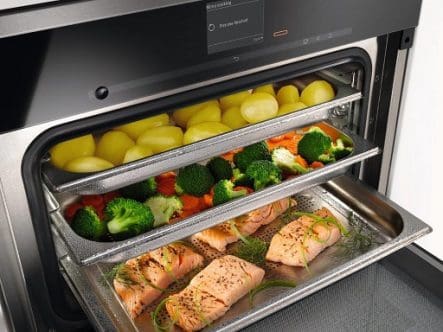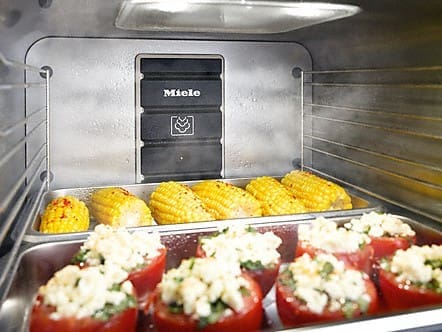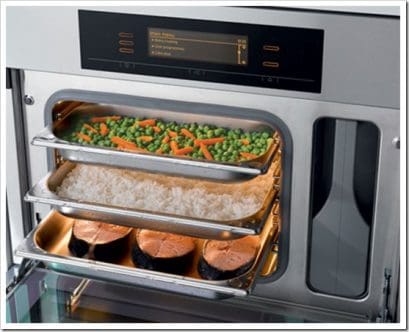
What is a Steam Oven?
Good cooking is an art – Great cooking is a science. To create a masterpiece, adding steam is as important as the quality of ingredients that you use. This is because water molecules conduct heat faster than hot air, so cook more thoroughly.
A steam oven does everything your current oven does, but it will take your cooking to the next level. A conventional oven surrounds food with dry heat but a steam oven will add steam to the process. This extra moisture improves flavour, texture and colour while preserving crispiness – turning every meal into a masterpiece.
How do Steam Ovens Work?
A steam oven requires you to add tap water to its (easily accessible) reservoir which is then heated to 100°, by a separate element within the oven, turning it into steam. The steam is then injected into the oven during cooking, which leaves the food moist and flavoursome as it cooks.

Are There Different Types of Steam Ovens?
Yes, there are three types of steam oven.
Part-Steam – This type of steam oven has two ways of cooking; as a conventional fan oven or using part steam. When using the steam function, it combines steam with traditional heat and food is cooked gently from the outside to the centre.
Full Steam – This type of steam oven has three ways of cooking; as a conventional fan oven, using part steam (as above) or using its full steam setting. The right amount of steam is used to cook your roasts, cakes and desserts to perfection.
Sous Vide – This type of steam oven has four ways of cooking; as a conventional fan oven, using part steam, using full steam or using its sous vide function. Sous vide cooking uses vacuum packed food and gently steams at very low temperatures.

What are the Benefits of Cooking with Steam?
- Steam prevents the food from drying out as it keeps maximum moisture in the food.
- Food is evenly cooked which eliminates ‘hot-spots’. Steam ovens are great for heating up leftovers and leave them tasting like a freshly cooked meal.
- Steam preserves the colour and flavour of the food and it can retain up to 25% more of the vitamin content so, it’s a very healthy way to cook your meals.
- Steam prevents flavour exchange between different dishes so you can confidently cook your fish dish and dessert at the same time.
- Because food cooks evenly and efficiently, the temperature can be set lower than on a conventional oven and so can the time.
What if the Water Runs out in the Oven?
Steam ovens will let you know when the water is running low, so you just need to keep an eye out for the warning light. The size of the water reservoir varies with makes and models and the speed in which the water is used depends on the type of food being cooked and the duration of cooking. The consumption of water in the reservoir will increase the more the door is opened during use, but it can always be topped up as it’s cooking. If it does run out completely, you won’t damage the oven, but it won’t function as a steam oven.

Do all Steam Ovens have a Reservoir to Fill?
No, there are a selection of steam ovens that can be plumbed into the mains water. These appliances are usually available in the high-end brands, such as Miele and Gaggenau. When the oven is connected to the mains, the intake and drainage of water is completely automatic making the appliance always ready for use.


Are Steam Ovens Expensive and is it Worth Paying the Extra?
Depending on the make, model and functions that you opt for, steam ovens will cost around 60-95% more than a standard electric fan oven.
If you’re a budding chef, enjoy fresh flavours and like to cook and eat healthily, a steam oven is a must. Even if you use it more for heating up leftovers and cooking shop-bought pizzas, the benefits of steam cooking are still considerable. The even spread of heat eliminates burnt edges on your food and they cook so much quicker than a standard oven too so, are good for the impatient. In summary, they are worth the extra cost providing you make full use of the functions available.






